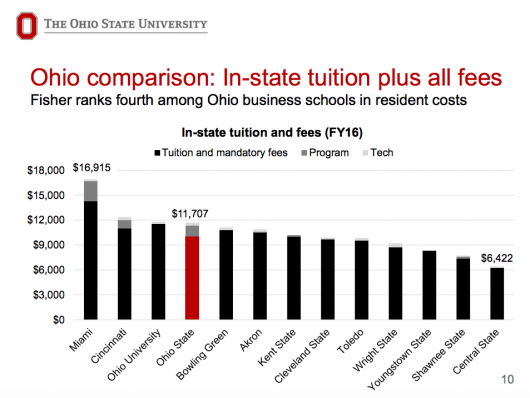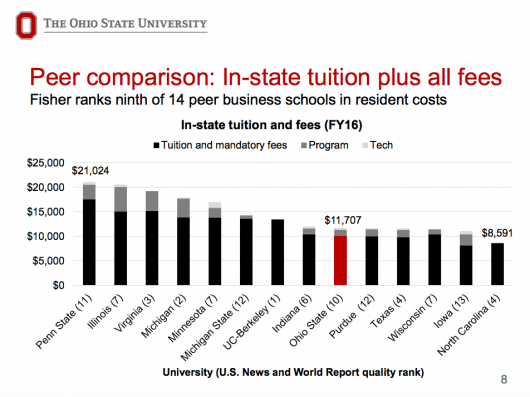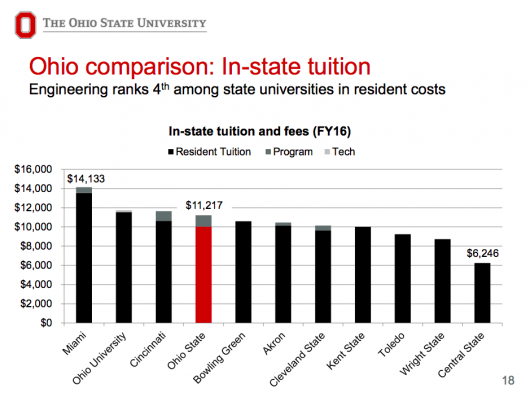
A slide from the draft proposal for increased fees shows that the Fisher College of Business ranks fourth in tuition and fees for the 2016-2017 school year. In September, the Board of Trustees is set to hear a proposal to increase fees by $3,375. Credit: Courtesy of Ohio State
While in-state tuition at Ohio State has been frozen for the past five years, some incoming students in the class of 2021 might be paying more than $3,000 more than their peers.
A proposal for an increase in instructional fees for both the Fisher College of Business and the College of Engineering is set to be introduced to the Board of Trustees at its next meeting in September. The new fees would apply to students enrolling at OSU starting Autumn Semester 2017.
Current in-state tuition and mandatory fees at OSU total at $10,037 for full-time, in-state students. At the Fisher College of Business, tuition and fees total $11,707, while at the College of Engineering it’s $11,217.
The proposals, which are subject to the board’s approval, would increase fees at Fisher from $1,670 to $5,045, and fees at the College of Engineering from $1,180 to $4,660, according to a draft of the proposal. If approved, in-state tuition would be $15,082 and $14,697, respectively.
The fees apply to in- and out-of-state students, meaning out-of-state tuition and fees would rise at Fisher from $28,899 to $33,274, and from $29,409 to $32,889 at the College of Engineering, assuming out-of-state tuition stays the same. However, out-of-state tuition has increased each year since 2012-13 freeze, unlike it’s in-state counterpart.
University spokesman Chris Davey noted that although the new fees would be introduced at the September meeting, the board won’t be voting on whether to adopt them until later in the year.
Reasoning
The proposals came from separate discussions with the deans of both colleges, university Provost Bruce McPheron told The Lantern. He said one of the main concerns was the student-to-faculty ratio in both colleges.
“The student-to-faculty ratio is something we can benchmark, and in both of those programs we have really lagged,” McPheron said. “As the two deans came to talk to (OSU CFO Geoff Chatas) and me, that’s how we arrived at the proposals … which will be discussed with Board of Trustees.”
Over the past 10 years, according to the draft proposal, enrollment at Fisher has increased by 45 percent, while enrollment at the College of Engineering has increased by 60 percent. Full-time faculty, however, has increased by 28 percent at Fisher and remained “relatively flat” at the College of Engineering.
McPheron said that the price increases would invest back into the colleges. At Fisher, the draft proposal lists the goals of the fee increase as hiring 32 new faculty, five new advisors and bringing in $2.7 million in new technology. Additionally, 50 percent of those new hires are proposed to be “women and/or under-represented minorities,” according to the draft proposal.
At the College of Engineering, the money would provide for 70 new faculty positions, “start-up investments, including lab space,” and “(attracting) $19 million in research activity.”
Cost-comparisons
Among the consideration for the proposed fee increases were college rankings and comparisons in tuition among other public colleges.

The draft proposal for fee increases lists the Fisher College of Business as having the 9th highest tuition of 14 “peer business schools.” Credit: Courtesy of Ohio State
Compared to what the proposal lists as 14 “peer business schools,” which include Big Ten rivals such as Pennsylvania State University and the University of Iowa, as well as schools such as University of California-Berkeley and the University of Virginia, Fisher ranks the ninth highest in in-state tuition and fees, 13th in out-of-state tuition and fees, and 10th in the U.S. News & World Report business school rankings.
Among public colleges in Ohio, Fisher ranks fourth highest in in-state tuition and fees, behind Miami University, the University of Cincinnati and Ohio University, respectively. If the fee increase is approved, Fisher would be the second-most expensive public business school in Ohio, behind Miami’s $16,915 tuition and fees.

The draft proposal for increased fees lists OSU’s College of Engineering as having the fourth highest in-state tuition and fees among Ohio public colleges. If adopted, the $3,480 fee increase would make Ohio State’s engineering program the most expensive in the state, though not the most expensive in the Big Ten — that title goes to Pennsylvania State University, where in-state tuition and fees for engineering are just over $20,000. Credit: Courtesy of Ohio State.
For the College of Engineering, its in-state tuition and fees put it at No. 8 among Big Ten schools, and 11th when considering out-of-state tuition. Among public schools in Ohio, it ranks fourth highest in in-state tuition, behind Miami, OU and UC, respectively. It would be the most expensive option for engineering in the state for Ohio residents if the new fees are approved, ahead of Miami by about $500.
Concerns
When asked about the increase in cost of earning an engineering or business degree, McPherson said he was comfortable with the new fees.
“We are constantly thinking about the balance of affordability,” McPheron said. “You always would like to have your costs as low as possible, but if, in fact, we’re committed to having enough of the absolutely best professors in these classrooms, we feel that the value to the student is still an exceptional value.”
McPheron also pointed out that the proposal addresses students who might not be able to afford the increases. According to the draft proposal, families earning equal to or less than the median annual income in Ohio, $53,000 a year, wouldn’t be subject to the increase. Additionally, those making between $53,000 and $120,000 would pay a discounted rate.
The proposal calculates this offset to add up to $5 million at Fisher and $7.5 million at the College of Engineering.
“You’ll notice there’s an acute focus on affordability in this proposal,” said Chatas.
Chatas also said he were confident that the increase in cost wouldn’t drive potential students away, citing the offsets for certain income groups but also student demand for OSU’s business and engineering programs.
“That’ll be part of the discussion with the board, but the short answer is no,” said Chatas. “We have robust demand for both programs, far more students apply than are admitted.”
Chatas also addressed concerns about the fees being hiked at once, instead of slower increases phased in over multiple years. He said the flat increase is more honest, comparing the upfront raise in fees to in-state tuition freezes of the past.
“We felt that the incoming students, with a year’s notice, would have the time available to absorb this and make this decision and be comfortable to manage the increase,” Chatas said. “Transparency and certainty are valuable for our students … so they can plan for their four years here.”
Chatas also said the large increase was more practical.
“So we looked at a number of a ways to do this,” Chatas said. “When you’re going to hire faculty, you need a long lead time to do this, and you need certainty of all of your sources of funding.”
The next Board of Trustees meeting is scheduled to take place Sept. 1 and 2. The agenda has not been finalized.


